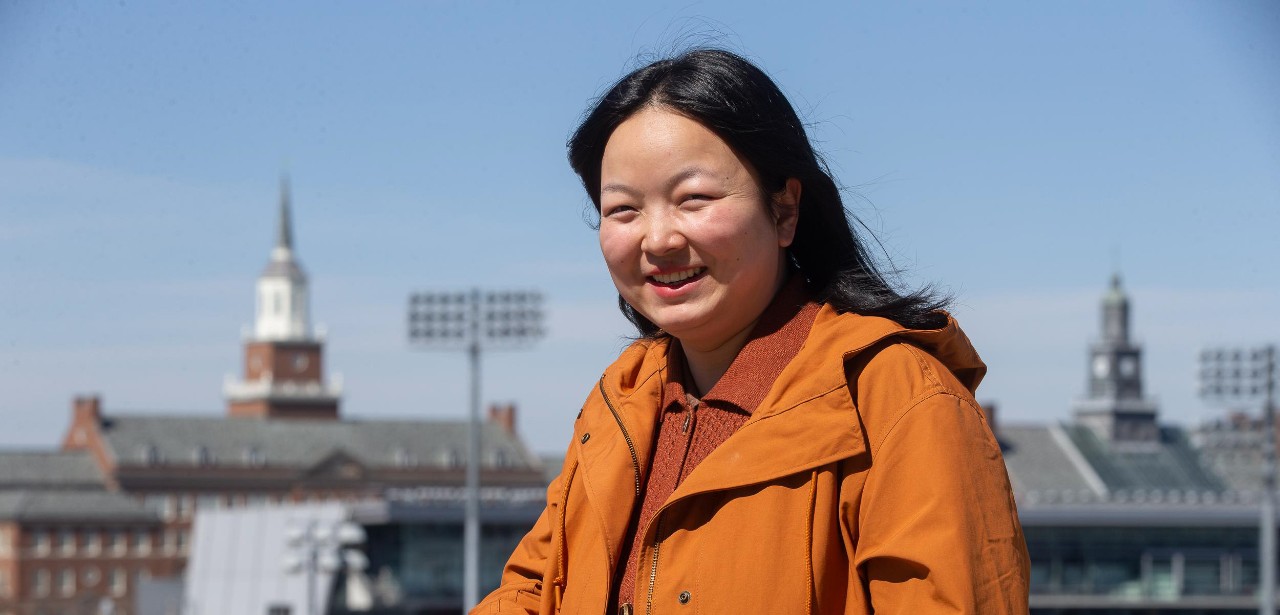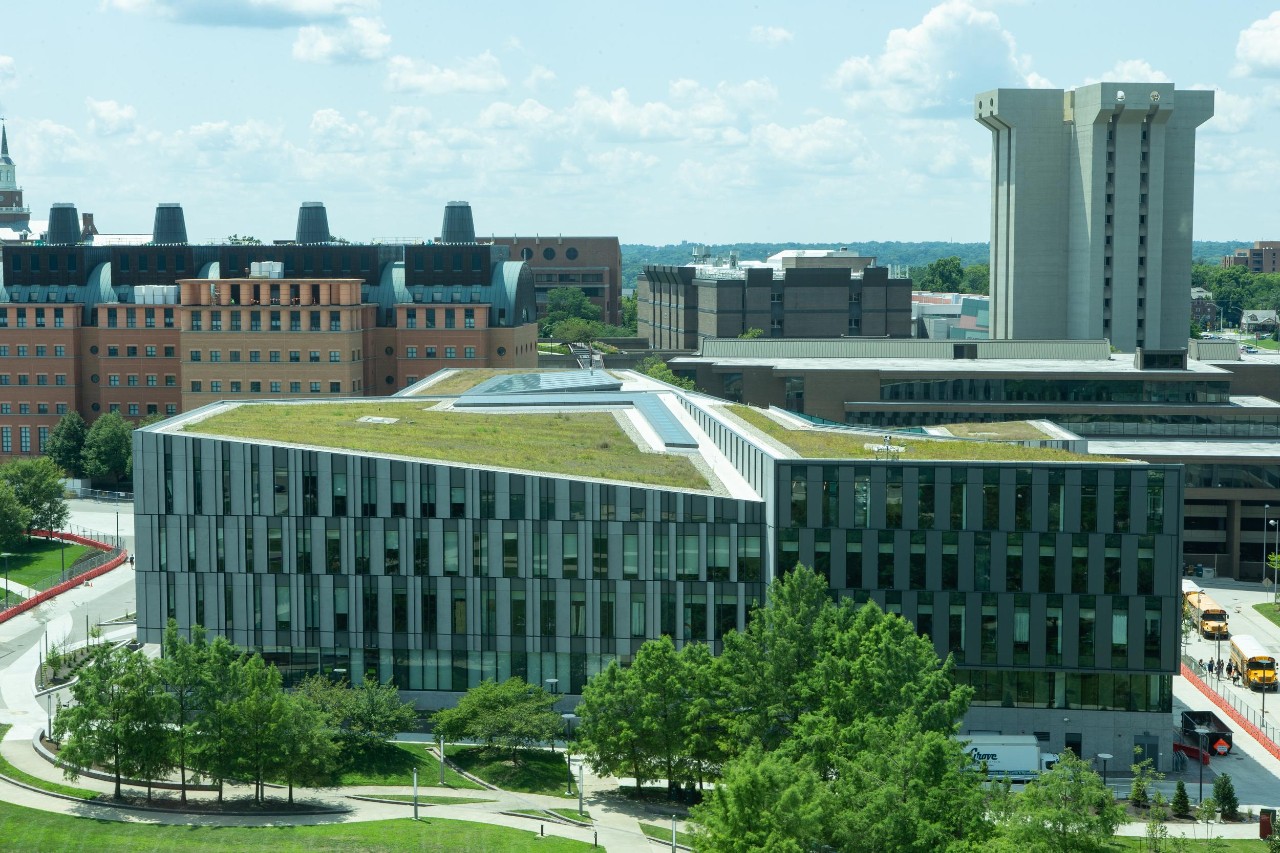
Focus turns to flood prevention in face of climate change
UC geography study finds detention basins often work best
Planners have come up with many innovative ways to prevent flooding caused by heavy downpours — from planting rain gardens to installing green roofs.
But in many cases, nothing works quite as well as a simple hole in the ground — a detention basin.
That’s the finding of an analysis by University of Cincinnati geography students in a research collaboration with the Hamilton County Conservation District.
Lead author and UC College of Arts and Sciences doctoral student Man Qi said cities are developing new ways to trap rainwater and direct it where it’s most wanted, especially during droughts. They call these low-impact development practices, which include innovations such as permeable pavement that allows rainwater to seep into the ground instead of diverting it elsewhere.

The Civic Garden Center of Greater Cincinnati features a green roof that helps collect rainwater. Photo/Andrew Higley/UC Marketing + Brand
Another innovation is a bioretention cell composed of ornamental or landscaping plants atop soil specially designed to drain quickly spread over a thick bed of gravel that does likewise. This soaks up large volumes of rain without creating standing pools of open water.
New commercial or housing developments typically must prevent rainwater from spilling out to other neighboring properties or roads. Hard surfaces like buildings and parking lots can’t absorb heavy rains so planners must collect or divert the water to prevent property damage.
“A detention pond is a common practice,” Qi said. “It temporarily stores the water and releases it into the air or the groundwater or nearby streams at a low rate to reduce the risk of flooding. It also provides some ecological benefits.”
Qi worked with the Hamilton County conservation district to measure the effectiveness of flood-prevention techniques such as detention basins and bioretention cells under five scenarios.

UC's Lindner College of Business features a green roof that collects rainwater on UC's uptown campus. Photo/Andrew Higley/UC Marketing + Brand
Qi presented their results at the annual American Association of Geographers’ conference in Denver.
“In residential areas where the impervious area is less than 40%, low-impact development practices are better. But if 70% or more of the ground surface is impervious, it’s best to put in detention basins,” Qi said. “The flood risk can be greatly reduced.”
Climate change is expected to increase both the frequency and severity of rainstorms, which means making deliberate plans for drainage will become even more important in cities, said Professor Lin Liu, a study co-author and co-director of UC’s Joint Center of GIS and Spatial Analysis.
My sister's family was badly affected by the flooding. It was very scary.
Man Qi, UC doctoral student
With their hard reflective surfaces, cities tend to trap heat, raising the ambient temperature by as much as 7 degrees during the day. This urban heat island effect can provide more energy for damaging storms, Liu said.
“Global warming and urban sprawl have contributed to extreme weather,” he said. “Coupled with the urban heat island effect many metropolitan cities have experienced more extreme precipitation events. As a result, urban flooding has become an increasing threat to the loss of human life and property damage in many cities around the globe.”
“You can see the extreme rainfalls happen more frequently,” Qi added. “Intense, heavy rains could inundate networks designed to prevent flooding and the capacity of drainage networks could fail because they simply can’t hold that much stormwater.”
The issue of urban flooding became real for Qi in 2021 when her sister’s home was inundated by floodwaters in China’s Zhengzhou City. More than 10 million people were affected by the disaster, which was one of the most severe floods in the city’s history. As much rain fell in a single day as the city sometimes sees in an entire year.
“My sister’s family was badly affected by the flooding. The water flooded their garage. Their cars were underwater,” she said. “It was very scary.”
The flood killed nearly 400 people and caused $10 billion in property damage.
Qi said flooding disproportionately affects lower-income residents who don’t have the resources to recover as quickly from a disaster.
Flood insurers create maps around these once-in-a-century disasters. But because of climate change, they are happening more frequently, Qi said.
“Floods affect roads and infrastructure and interrupt society,” Qi said. “Schools are closed. Businesses are closed. The impacts are widespread.”
Featured image at top: University of Cincinnati doctoral student Man Qi is studying ways to prevent flooding in cities. Photo/Andrew Higley/UC Marketing + Brand
Next Lives Here
The University of Cincinnati is leading public urban universities into a new era of innovation and impact. Our faculty, staff and students are saving lives, changing outcomes and bending the future in our city's direction. Next Lives Here.
Related Stories
History Department Lecture
January 9, 2002
Lecture by Allan W. Winkler, Miami University, Oxford on "Urban America in World War II: Cincinnati as an example" at the Cincinnati Museum Center at 7:30pm.
UC Research Ranking Climbs
January 10, 2002
The University of Cincinnati moved up in two different national rankings established by the National Science Foundation (NSF) to compare college and university research efforts.
History Department Lecture
January 17, 2002
Lecture by Leslie Adelson, Cornell University, will deliver a Taft lecture titled "Back to the Future and Beyond 'Two Worlds':Turkish Lines of Thought in Contemporary German Literature and Memory Work" at 3:00pm in the Max Kade German Cultural Center in Old Chemistry.
New Appointments in McMicken Administration
January 21, 2002
The college is very pleased to announce two new appointments.
Sign Up for the Discovering A&S Elective
January 24, 2002
Parent's Asking, "What does someone do with THAT major?" Don't know all your options? Sign up for a 2 credit hour elective where you can meet A&S faculty, emeriti faculty, as well as, alumni.
Three of Four UC Fulbrights Scholars from McMicken
January 28, 2002
Tainted water supplies in Bangladesh, international security and missile defense, transformations in Mexico and greater understanding of India - this varied list sums up the work of four Fulbright Scholars at the University of Cincinnati who are concentrating on real-life issues involving our neighbors around the world.
Prominent Line-Up Examines Race in 2002 Ropes Series
January 31, 2002
The issue of race will receive one of the most intensive examinations undertaken in Cincinnati since the April riots when the University of Cincinnati Department of English launches its Ropes series in January and February 2002.
Nominate a Distinguished Alumni
January 31, 2002
The Purpose of the Distinguished Alumni Awards is to recognize graduates of the McMicken College of Arts and Sciences for outstanding achievements.
UC Physicists Play Important Role in Experiments That Provided New Understanding of Neutrinos
January 31, 2002
Three physicists at the University of Cincinnati played a key role in recent experiments which provided a surprising new understanding of a tiny subatomic particle known as the neutrino.
Angelene Jamison-Hall: Publishing Award
February 13, 2002
An unpublished novel by Angelene Jamison-Hall won first place in the new writing contest sponsored by River View Publishing in Riverside, Iowa.
